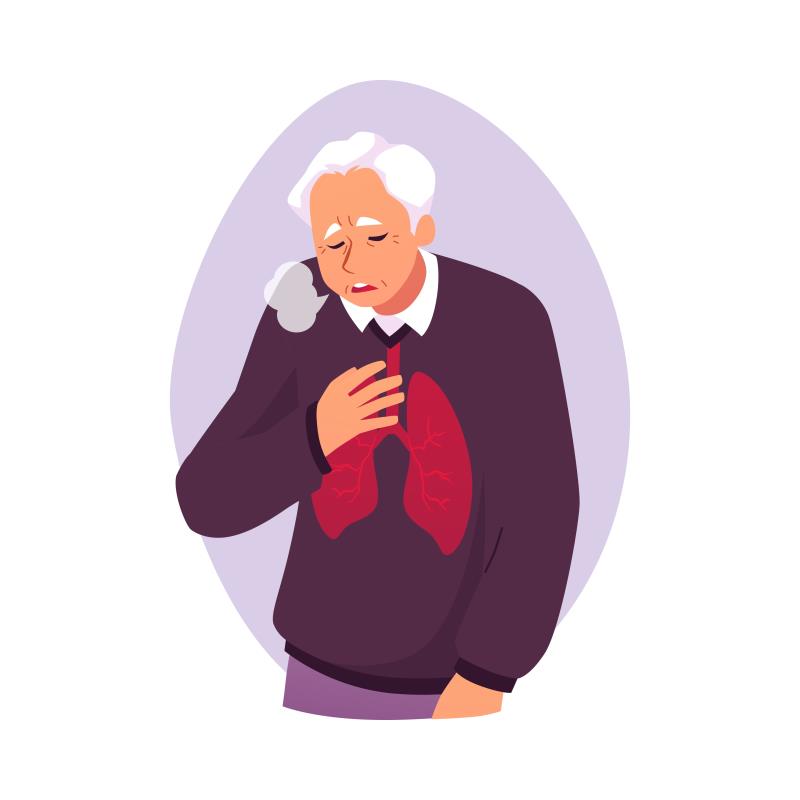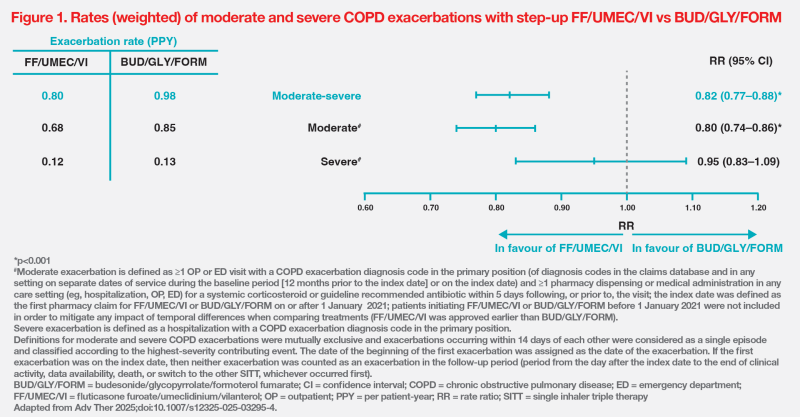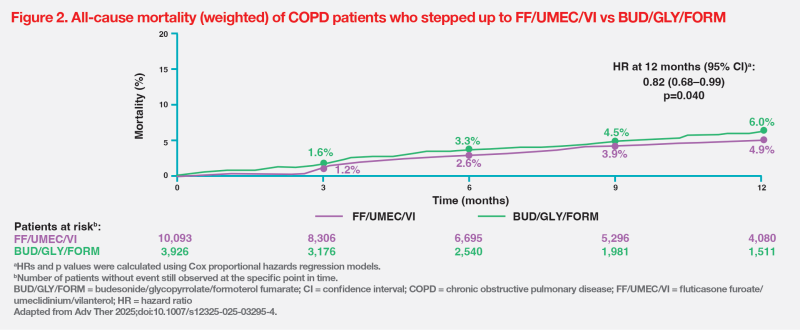
Stepping up to triple therapy with inhaled corticosteroid (ICS) plus a long-acting muscarinic antagonist (LAMA) and a long-acting β2-agonist (LABA) is recommended for patients with chronic obstructive pulmonary disease (COPD) inadequately controlled with dual therapy. The use of single-inhaler therapy has also been recommended over the use of multiple inhalers, as convenience has been associated with better treatment adherence and effectiveness. This article highlights the results of the first real-world comparative effectiveness study of two single-inhaler triple therapy (SITT) formulations, fluticasone furoate/umeclidinium/vilanterol (FF/UMEC/VI) and budesonide/ glycopyrrolate/formoterol fumarate (BUD/GLY/FORM), in patients who stepped up from prior dual combination therapy.
Recommendations on SITT use
The Global Initiative for Chronic Obstructive Lung Disease (GOLD) strongly recommends the use of triple therapy in COPD patients with ≥2 moderate exacerbations (or ≥1 exacerbation leading to hospitalization) per year and blood eosinophils levels ≥300 cells/μL. For patients on long-acting bronchodilators with eosinophil counts of 100 to <300 cells/ μL and one moderate exacerbation per year, addition of ICS to existing dual (LAMA/LABA) therapy is recommended. GOLD discourages the use of ICS/LABA combinations and suggests that if there is an indication for an ICS, the preferred choice would be ICS/LAMA/LABA triple combinations due to their demonstrated superiority to ICS/LABA combinations. [https:// goldcopd.org/2025-gold-report/]
In Hong Kong, the FF/UMEC/VI dry powder inhaler (DPI) and BUD/GLY/FORM metered-dose inhaler (MDI) are SITTs approved for maintenance treatment of COPD patients whose disease is not adequately controlled with dual therapy (whether ICS/LABA or LAMA/LABA). [Trelegy Ellipta Hong Kong Prescribing Information, version HK052023; Breztri Aerosphere Hong Kong Prescribing Information]
Step up from dual therapy: Comparative effectiveness of two SITTs
A real-world comparative effectiveness study evaluated FF/UMEC/VI and BUD/GLY/FORM (which are also approved in the US for COPD maintenance treatment) in COPD patients in the US. [Adv Ther 2025;doi:10.1007/ s12325-025-03295-4]
The retrospective weighted cohort study, which aimed to fill a knowledge gap and aid clinicians in making informed decisions, used data between January 2016 and December 2023 from the Komodo Research healthcare claims database to identify patients with COPD and Medicare Fee-for-Service insurance on dual therapy as their most recent treatment in the 90 days pre-index, who stepped up to FF/ UMEC/VI (n=10,093) or BUD/GLY/FORM (n=3,926) (mean age, 73.7 years; female, 53.9 percent; ICS/LABA, 66.2 percent for both groups).
FF/UMEC/VI: Lower rate and risk of moderate-severe exacerbations
The annualized rate of moderate-severe COPD exacerbations, which served as the primary outcome of the study, was significantly lower by 18 percent in patients who stepped up to FF/UMEC/VI vs those who stepped up to BUD/GLY/FORM (0.80 vs 0.98 per patient-year [PPY]; rate ratio [RR], 0.82; 95 percent confidence interval [CI], 0.77–0.88; p<0.001). (Figure 1)

Stepping up to FF/UMEC/VI was also associated with a significant 14 percent reduction in risk of time to first moderate-severe COPD exacerbation (secondary outcome) vs BUD/GLY/ FORM at 12 months (43.6 vs 49.0 percent; hazard ratio [HR], 0.86; 95 percent CI, 0.81–0.92; p<0.001).
Lower all-cause mortality risk
Patients who stepped up to FF/ UMEC/VI had an 18 percent significantly lower risk of all-cause mortality vs those who stepped up to BUD/GLY/ FORM at 12 months (4.9 vs 6.0 percent; HR, 0.82; 95 percent CI, 0.68–0.99; p=0.040). (Figure 2)

Factors contributing to favourable outcomes
The researchers postulated that several factors may have contributed to the favourable outcomes observed in patients treated with FF/UMEC/VI. Differences in efficacy of the component molecules of the two SITTs could be a factor, as supported by the phase III AERISTO double-blind, randomized controlled trial showing that GLY/FORM was inferior to UMEC/VI in morning pre-dose trough forced expiratory volume in 1 second (FEV1) despite being superior in onset of action in patients with moderate-to-very severe COPD. [Adv Ther 2025 doi:10.1007/s12325-025-03295-4; Adv Ther 2019;36:2434-2449]
Greater adherence to FF/UMEC/ VI could be another factor, as its dosing regimen requires only once daily inhalation vs two daily inhalations with BUD/ GLY/FORM. Inhaler device type (DPI vs MDI) may also be a contributing factor, and patients’ preference for continuity of device may play a role in the treatment prescribed.
Results consistent with earlier real-world studies
The findings of this study are consistent with earlier comparative effectiveness and safety studies in patients with COPD newly initiated on the SITTs. These studies similarly included patients with COPD reflective of the approved indications and real-world practice, using dosing regimens according to the approved labels. [Adv Ther 2025;42:1131-1146; BMJ 2024;387:e080409]
Notably, one of the studies found no difference in the safety profile between the SITTs, as assessed by the risk of hospitalization due to pneumonia, alleviating concerns of fluticasone’s pneumonia risk (observed in some studies) due to slower airway absorption, higher lipophilicity and more potent immunosuppressive effects. [BMJ 2024;387:e080409; Int J Chron Obstruct Pulmon Dis 2020;15:2889-2900]